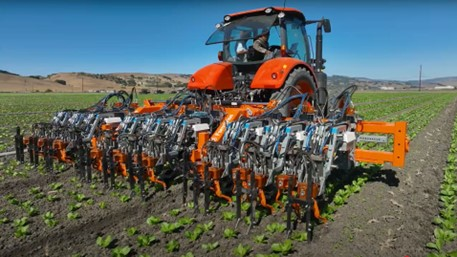Oct 30, 2024
Diseases of Cole crops
Gearing up for the produce season, we already have been seeing plenty of fields transplanted with cole crops (cauliflower, cabbage, broccoli, etc). Below are the few common diseases to watch out for.
Damping-Off
This disease commonly affects seeds and young transplants and is caused by the soil-borne fungi such as Pythium, Fusarium, Rhizoctonia etc. Infected seeds decay in the soil. Seedlings and young transplants will “damp-off” or rot at the soil line, before they eventually collapse and die.
The fungus, Rhizoctonia solani, causes wirestem. Stems of plants become constricted and brittle at the soil line. The plant becomes stunted and may rot at the soil line. This disease is more severe on fall cole crops when the soil is warm. We have seen lot of this problem in the fields last year. Make sure you get certified disease-free seedlings.
Prevention & Treatment: Cultural controls include planting on raised beds and providing good drainage. In greenhouse where transplants are grown, use new potting soil and new or thoroughly cleaned and disinfested containers and trays. Wash used containers with soapy water to remove all traces of old soil mix, and then briefly submerse containers in a 10% bleach solution. Allow to dry before planting in containers. Both in greenhouse and fields: avoid overwatering and wet feet in plants/seedlings.

Black Rot
Black rot is another common disease we observed in the fields last growing season. Black rot is caused by a bacterium, Xanthomonas campestris pathovar campestris, and can affect all vegetables in the crucifer family. Above-ground parts of the plant are primarily affected, and symptoms may vary depending on the type of plant, age of the plant and the environmental conditions. In general, yellow, V-shaped lesions appear along the tips of the leaves with the point of the V directed toward a vein. When lesions enlarge, wilted tissue expands toward the base of the leaves. Veins turn black or brown. Infection may spread into the stems. Cutting into the stems often reveals a black-brown discoloration with a yellowish slime present. Symptoms on cauliflower may appear as numerous black or brown specks, black veins and discolored curds.

Prevention & Treatment: With no effective curative measures available, preventative measures are very important. The bacteria survive the winter on plant debris and on weeds, such as wild mustard and Shepherd’s purse. It also can survive in and on seeds from infected plants. It can remain alive on plant residue buried in the soil for up to two years. The disease is easily spread by splashing water, wind, insects and garden tools. High temperatures and humidity favor development of the disease.
Use certified disease-free seed and transplants. If source of the seeds is unknown, or infested seed lots must be used, treat seed with hot water to eradicate pathogenic bacteria. Cabbage, broccoli, and Brussels sprouts can be treated at 122 °F for 25 minutes, while seeds of cauliflower, kale, turnip, and rutabaga are treated for 15 minutes. However, this treatment may reduce the viability of seed.
Choose varieties tolerant to black rot. Do not plant cole crops where black rot has occurred in the past two to three years. Select well-drained sites with good air circulation.
Downy Mildew
This disease is caused by the fungus Peronospora parasitica and can attack both seedlings and mature vegetable plants. Infected plants develop a gray mold on the lower leaf surface. The upper leaf surface of infected plants first turns yellow and then may turn brown or necrotic. Leaves wither and die. Symptoms differ from powdery mildew in that the downy mildew fungus grows only on the lower surface of the leaf. Development of the disease is favored by moist conditions.

Downy mildew symptoms on a collard leaf. Justin Ballew, ©2020, Clemson Extension
Prevention & Treatment: Use varieties with resistant varieties. Rotate with crops other than cole crops or greens. Remove plant debris immediately after harvest. Use wide plant spacing to promote drying of leaves. For chemical control, make sure to rotate the fungicides to avoid development of resistance.
Alternaria Leaf Spot
Alternaria leaf sport is a common problem and sometimes may not be of economic importance. However, if the plants are already weak or physically damaged providing the site of infection, the disease can cause economic losses.


Article source: https://hgic.clemson.edu/
2024-2025 growing season field trials
With the start of 2024-2025 growing season, we are gearing up for field trials on vegetables. Listed below are our research trials for this growing season addressing the need of the agriculture community. For more information and/or collaboration contact: bpoudel@arizona.edu
Integrated management of downy mildew in lettuce:

Three different most commonly grown iceberg lettuce cultivar will be evaluated against downy mildew using different chemical treatments. Partially funded by Arizona Iceberg Lettuce Research Council.
Sclerotinia drop of Lettuce

In this game of all or nothing, we will continue to do field trials on sclerotinia drop of lettuce. We will be doing trials on both species S. sclerotirum and S. minor.
Powdery mildew of lettuce

We will continue with field trials on powdery mildew of lettuce.
Downy mildew of Spinach
Downy mildew of spinach field trials won’t start until January of next year. But we are requesting industry reps to contact us ahead of time.
For more information: bpoudel@arizona.edu,928-920-1110

 To contact John Palumbo go to: jpalumbo@ag.Arizona.edu
To contact John Palumbo go to: jpalumbo@ag.Arizona.edu

























